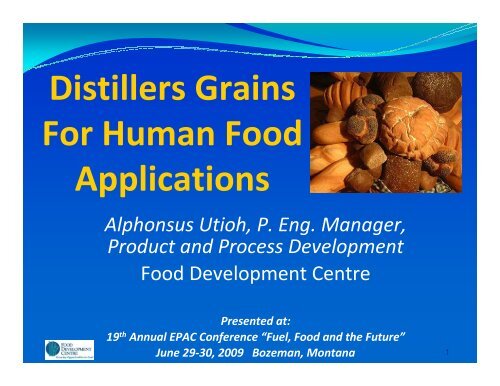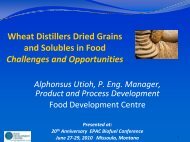Coproducts
Distillers Grains For Human Food Applications - Ethanol Producers ...
Distillers Grains For Human Food Applications - Ethanol Producers ...
- No tags were found...
You also want an ePaper? Increase the reach of your titles
YUMPU automatically turns print PDFs into web optimized ePapers that Google loves.
A Kernel of<br />
Wheat<br />
Endosperm: 83%<br />
- Low in lipids, dietary<br />
fibre, minerals, high in<br />
starch<br />
Bran: 14.5%<br />
- Rich in dietary fibre,<br />
phytochemicals and<br />
low in starch<br />
Germ: 2.5%<br />
- Rich in proteins, lipids,<br />
low in carbohydrates3
Typical Ethanol Process<br />
Corn / Wheat<br />
Milling<br />
Alpha-amylase Liquefaction Water<br />
Gluco-amylase<br />
Saccharification<br />
Yeast<br />
Fermentation<br />
CO 2<br />
95% Ethanol<br />
Distillation<br />
Whole Stillage<br />
Dehydration<br />
Thin Stillage<br />
Decanting<br />
DWG<br />
Gasoline<br />
Denaturing<br />
Evaporation<br />
Syrup<br />
Drying<br />
Fuel Ethanol<br />
DDG(S)<br />
4
Characterization of Distillers<br />
Grains<br />
Distillers Dried Grains with Solubles is the<br />
product obtained after removal of alcohol<br />
by distillation from yeast fermentation of<br />
a grain or grain mixture and drying the<br />
resultant whole stillage.<br />
100 kg of corn fermented produces:<br />
36 liters of ethanol<br />
32 kg of DDGS<br />
32 kg of carbon dioxide<br />
Source: University of Minnesota
Distillers Wet Grains (DWG)<br />
Corn DWG<br />
Wheat DWG<br />
Wet cake or crumb<br />
Dark yellow color<br />
Fermented odor<br />
Wet cake or crumb<br />
Brown color<br />
Fermented odor<br />
6
Chemical Composition<br />
Protein (%, db) (N x 6.25)<br />
Wheat<br />
13.1<br />
Wheat<br />
DWG<br />
40.5<br />
Wheat<br />
DDGS<br />
40.4<br />
Carbohydrate (%, db)<br />
82.0<br />
46.7<br />
46.2<br />
Energy (Cal/100g, db)<br />
409<br />
438<br />
421<br />
Moisture (%)<br />
11.0<br />
69.4<br />
4.3<br />
Ash (%, db)<br />
1.7<br />
2.9<br />
5.1<br />
Fat (%,db)<br />
3.1<br />
9.8<br />
8.3<br />
Total Dietary Fibre (%, db)<br />
13.0<br />
32.7<br />
44.2<br />
Insoluable Dietary Fibre (%, db)<br />
11.2<br />
29.7<br />
42.6<br />
Soluble Dietary Fibre (%, db)<br />
1.8<br />
2.9<br />
1.6<br />
9
Characterization of DDGS<br />
Heavy Metals (ppm)<br />
Wheat<br />
Wheat<br />
DWG<br />
Wheat<br />
DDGS<br />
Arsenic<br />
< 0.1<br />
< 0.1<br />
< 0.1<br />
Cadmium<br />
0.1<br />
< 0.1<br />
0.2<br />
Mercury<br />
< 0.1<br />
< 0.1<br />
< 0.1<br />
Lead<br />
0.2<br />
< 0.1<br />
< 0.1<br />
10
11<br />
Characterization of DDGS<br />
4096<br />
628<br />
1,101<br />
Mg<br />
10,710<br />
1,576<br />
3,370<br />
K<br />
149<br />
42<br />
32<br />
Fe<br />
14<br />
9<br />
12<br />
Cu<br />
2<br />
3<br />
2<br />
Cr<br />
2<br />
5<br />
4<br />
Co<br />
1,631<br />
455<br />
410<br />
Ca<br />
78<br />
28<br />
75<br />
Zn<br />
8<br />
8<br />
7<br />
Sr<br />
9,999<br />
1,762<br />
2,777<br />
P<br />
2<br />
5<br />
5<br />
Ni<br />
369<br />
55<br />
2<br />
Na<br />
96<br />
22<br />
35<br />
Mn<br />
Wheat DDGS<br />
Wheat DWG<br />
Wheat<br />
Minerals (µg/g)
Drying Technologies for<br />
Distillers Grains<br />
Drying technologies affect distillers grains<br />
appearance, taste, flavour and nutrition<br />
Technologies include<br />
Open flame<br />
Air drying at ≤100 o C<br />
Drum drying<br />
Freeze drying<br />
Spray drying for thin stillage<br />
12
DWG Drying Procedure<br />
Commercial DWG<br />
Frozen DWG<br />
Thawing<br />
DWG<br />
DWG<br />
DWG<br />
Drum<br />
Drying<br />
Air Drying<br />
Freeze<br />
Drying<br />
DDG<br />
DDG<br />
DDG<br />
13
Air Drying<br />
Wet cake spread thinly on<br />
trays inside drying chamber<br />
Drying for about 6 hours at<br />
50°C<br />
Initial moisture ~ 70%<br />
14
Drum Drying<br />
• Rotating drum heated<br />
internally with steam<br />
• Slurry is poured onto<br />
the drum<br />
• Dried product is<br />
removed by scrapping<br />
15
Freeze Drying<br />
• Based on sublimation<br />
(solid to gas)<br />
• Wet material is placed<br />
on trays in the drying<br />
chamber<br />
16
Dried Products (Wheat-based)<br />
DDGS Air dried Drum dried Freeze dried<br />
DDG<br />
17
Visual Comparison Commercial<br />
and Drum Dried DDGS<br />
Commercial DDGS<br />
Drum Dried DDGS<br />
19
Nutritional Results for<br />
Drum Dried DDGS<br />
(% db)<br />
Moisture<br />
Dry Matter<br />
Crude Protein<br />
Crude Fibre<br />
Fat<br />
Ash<br />
Husky<br />
DDGS<br />
7.62*<br />
92.38<br />
43.79<br />
11.40<br />
4.87<br />
4.97<br />
Drum Dried<br />
DDGS<br />
4.29*<br />
95.71<br />
39.23<br />
9.18<br />
4.57<br />
5.15<br />
20
Drying Summary<br />
• Low microbial load for all techniques<br />
• Added solubles change mineral content of DDG,<br />
specially K, Mg & P<br />
Air drying<br />
Reduced<br />
fermented<br />
aroma<br />
Retained<br />
fermented taste<br />
Colour was dark<br />
as commercial<br />
Drum drying<br />
Product with the<br />
best odour &<br />
taste<br />
Freeze drying<br />
Gave the dullest<br />
colour<br />
Fermented<br />
aroma decreased<br />
Fermented taste<br />
remain<br />
21
Thin Stillage<br />
• Liquid part of whole stillage<br />
• Rich source of soluble protein & fibre<br />
• Generally concentrated & added back to<br />
distillers grains (DDGS)<br />
• Usual process Evaporation<br />
22
Process Flow<br />
Thin Stillage<br />
Decanting<br />
Effluent<br />
Precipitate<br />
Grinding/ Homogenization<br />
Homogenized Precipitate<br />
Spray Drying<br />
Thin Stillage Powder<br />
23
Spray Drying<br />
Before<br />
After<br />
24
Appearance<br />
•Fine, light beige powder<br />
•Low fermentation taste and smell<br />
25
Microbiological Results<br />
(Thin Stillage Powder)<br />
Characteristic<br />
Standard Plate Count<br />
Coliforms<br />
Yeast<br />
Mould<br />
Value (CFU/g)<br />
Nutritional Results<br />
(Thin Stillage Powder)<br />
Characteristic<br />
Moisture<br />
Protein<br />
Total Dietary Fibre<br />
Fat<br />
Carbohydrates<br />
Ash<br />
Energy (Cal/100g)<br />
Value (% db)<br />
10.9<br />
41.5<br />
21.7<br />
8.5<br />
42.5<br />
7.4<br />
368<br />
27
Mineral Content<br />
(Thin Stillage Powder)<br />
Mineral<br />
Potassium<br />
Phosphorus<br />
Magnesium<br />
Calcium<br />
Iron<br />
Zinc<br />
mg/100g (db)<br />
1416<br />
1342<br />
629<br />
228<br />
17<br />
7<br />
28
Heavy Metals<br />
(Thin Stillage Powder)<br />
Heavy Metal<br />
Arsenic<br />
Cadmium<br />
Mercury<br />
Lead<br />
Content (ppm)<br />
Essential Amino Acid Profile<br />
Amino Acid<br />
Isoleucine<br />
Leucine<br />
Lysine<br />
Methionine<br />
Phenylalanine<br />
Threonine<br />
Tryptophan<br />
Valine<br />
Thin Stillage (%)<br />
1.22<br />
3.12<br />
0.90<br />
0.47<br />
1.54<br />
1.65<br />
0.41<br />
1.23<br />
30
Development of Food Products<br />
with Distillers Grains<br />
Incorporate ethanol co-products<br />
into a variety of food products –<br />
cookies, bars, crackers and<br />
confectionary product<br />
Identify the maximum levels<br />
Assess the effect on the product’s<br />
sensory & nutritional properties<br />
Optimize the product formulations<br />
31
DDGS – Rye/Pumpernickel Bread<br />
• ~ 6% DDGS (total formula)<br />
• ~ 11% DDGS (flour replacement)<br />
• 4g of fiber per 50g serving<br />
• Allows for “High in Fiber” label claim<br />
• Scaled up formula to 16 x 1 lb loaves<br />
32
Summary<br />
DDGS from wheat-based ethanol is suitable for<br />
food applications including functional foods and<br />
nutraceuticals<br />
Products developed had acceptable sensory<br />
attributes and enhanced nutritional qualities<br />
Thin stillage can also be processed into high<br />
quality food ingredients<br />
For DDGS to have a future in the food industry,<br />
ethanol plants must bear GMPs in mind during<br />
construction<br />
33
Acknowledgement<br />
Manitoba Rural Adaptation Council (MRAC) and<br />
Canada-Manitoba Agri-food Research and<br />
Development Initiative (ARDI) for their financial<br />
support<br />
Husky Energy Minnedosa Ethanol Plant for allowing<br />
FDC research team full access to the ethanol plant in<br />
Minnedosa<br />
Canadian International Grains Institute (CIGI) and<br />
Grains Research Laboratory (GRL) for their technical<br />
support<br />
Product Development Team at FDC<br />
34
Thank You!<br />
FOOD DEVELOPMENT CENTRE<br />
A Special Operating Agency of Manitoba Agriculture,<br />
Food and Rural Initiatives<br />
P.O. Box 1240, 810 Phillips Street<br />
Portage la Prairie, Manitoba, R1N 3J9<br />
Phone: (204) 239-3150<br />
Toll-free: 1-800-870-1044<br />
Fax: (204) 239-3180<br />
Email: Alphonsus.Utioh@gov.mb.ca<br />
www.gov.mb.ca/agriculture/fdc<br />
35




